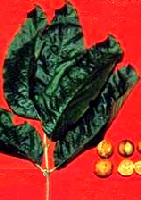| DESCRIPTION: It is a deciduous, profusely branched shrub or less often a small tree, 2-15 m tall, with smooth grey bark. Leaves opposite, elliptic-ovate or rotundate, dark green above, paler beneath, glabrous or, rarely, slightly pubescent, with acuminate or, rarely, obtuse or acute apex and prominent venation below, 7-20 x 2-11 cm. Flowers greenish-yellow, yellow or cream, fulvous-pubescent, borne in dense axillary cymes, sweet scented. Fruit globose, very smooth and shiny, 3-4.5 x 2.5-4.2 cm, greenish when immature, changing to yellowish-brown when ripe, contain 4-5 woody seeds up to 1.6 cm long. USE: The ripe fruit pulp is edible and has a pleasant chocolate-like flavour and the flowers are a source of honey. Wood is used as firewood and charcoal. Roots and bark are used in traditional medicine; for example, in Tanzania an extract from the roots is used to treat worm infections. GROWING PERIOD: Perennial. COMMON NAMES: Common wild medlar. FURTHER INF: It is commonly found in evergreen forest, riverine forest and bushland, wooded bushland and wooded grassland, and sometimes on rocky outcrops and termite mounds. Found throughout Africa from Ethiopia to Nigeria and south to South Africa and into Asia at sea level to 2400m. The plant is also cultivated in India, northern Australia and Trinidad. It grows naturally in riverine-lowland forests and Brachystegia-Combretum woodland. The species is fire sensitive. It can be found on volcanic ash soils, light yellowish-brown to reddish-yellow, gritty, sandy clay loams and red to dark red friable clays with lateritic horizon. |
